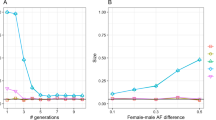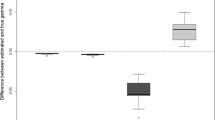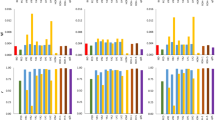Abstract
This paper extends an approach for estimating the ancestry probability, the probability that an inbred line is an ancestor of a given hybrid, to account for genotyping errors. The effect of such errors on ancestry probability estimates is evaluated through simulation. The simulation study shows that if misclassification is ignored, then ancestry probabilities may be slightly overestimated. The sensitivity of ancestry probability calculations to the assumed genotyping error rate is also assessed.



Similar content being viewed by others
References
Alderson GW, Gibbs HL, Sealy SG (1999) Parentage and kinship studies in an obligate brood parasitic bird, the brown-headed cowbird (Molothrus ater), using microsatellite DNA markers. J Hered 90:182–190
Berry AD, Seltzer DJ, Xie C, Wright LD, Smith CS (2002) Assessing probability of ancestry using simple sequence repeat profiles: application to maize hybrids and inbreds. Genetics 161:813–824
Boehnke M, Cox NJ (1997) Accurate inference of relationships in sib-pair linkage studies. Am J Hum Genet 61:423–429
Broman K, Weber J (1998) Estimation of pairwise relationships in the presence of genotyping errors. Am J Hum Genet 63:1563–1564
Chakraborty R, Meagher TR, Smouse PE (1988) Parentage analysis with genetic markers in natural populations. I. The expected proportion of offspring with unambiguous paternity. Genetics 118:527–536
Devlin B, Risch N, Roeder K (1996) Disequilibrium mapping: composite likelihood for pairwise disequilibrium. Genomics 36:1–16
Ellstrand NC (1984) Multiple paternity within the fruits of the wild radish, Raphanus sativus. Am Nat 123:819–828
Ewen K, Bahlo M, Treloar S, Levinson D, Mowry N et al (2000) Identification and analysis of error types in high-throughput genotyping. Am J Hum Genet 67:727–736
Garner C, Slatkin M (2002) Likelihood-based disequilibrium mapping for two-marker haplotype data. Theor Popul Biol 61:153–161
Lindsay BG (1988) Composite likelihood methods. Contemp Math 80:221–239
Marshall TC, Slate J, Kruuk LEB, Pemberton JM (1998) Statistical confidence for likelihood-based paternity inference in natural populations. Mol Ecol 7:639–655
Ott J (1991) Analysis of human genetic linkage (revised edition). The Johns Hopkins University Press, Baltimore
Rannala B, Slatkin M (2000) Methods for multipoint disease mapping using linkage disequilibrium. Genet Epidemiol 19(Suppl 1):S71–S77
San Cristobal M, Chevalet C (1997) Error tolerant parent identification from a finite set of individuals. Genet Res 70:53–62
Zhang H, Stern H (2003) Estimating genotyping error rate for maize using SSR profiles. Technical report. Department of Mathematics and Statistics, University of West Florida, Pensacola, FL 32514
Author information
Authors and Affiliations
Corresponding author
Additional information
Communicated by A. E. Melchinger
Rights and permissions
About this article
Cite this article
Zhang, H., Stern, H. Assessment of ancestry probabilities in the presence of genotyping errors. Theor Appl Genet 112, 472–482 (2006). https://doi.org/10.1007/s00122-005-0148-3
Received:
Accepted:
Published:
Issue Date:
DOI: https://doi.org/10.1007/s00122-005-0148-3




